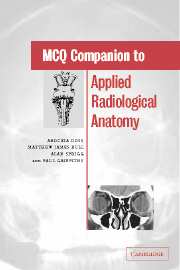Neuroradiology
Published online by Cambridge University Press: 04 February 2010
Summary
Regarding the imaging methods of the skull and brain:
(a) Skull radiograph is sensitive to cerebral pathology.
(b) Contrast between white and grey matter is superior on MRI compared to CT of the brain.
(c) The contents of the middle and posterior fossa of the brain are better visualized with CT than with MRI.
(d) On T1-weighted MRI, white matter has lower signal (darker) than grey matter.
(e) On T2-weighted MRI, grey matter has lower signal than white matter.
Regarding MRI of the brain:
(a) Cerebrospinal fluid has high signal on T1-weighted images.
(b) Cerebrospinal fluid has high signal on T2-weighted images.
(c) In a proton density MRI sequence, grey matter is hyperintense to white matter.
(d) In CT of the brain the white matter is darker than grey matter.
(e) The fornix and anterior commissure are hypointense on T2-weighted images.
Regarding the technique of brain CT and MR:
(a) The axial plane for CT is usually parallel to a line tangential to the orbital roofs running to the anterior margin of the foramen magnum.
(b) The normal choroid plexus and the pituitary gland enhance on postcontrast CT images.
(c) Mechanism of contrast enhancement of gadolinium DTPA is similar to that of iodinated contrast medium.
(d) Rapidly flowing blood is bright on a T1-weighted MRI.
(e) Time of flight MR angiography is an invasive procedure.
Neuroradiology ANSWERS
(a) False – investigation of choice for the detection of fractures, relatively insensitive to cerebral pathology.
(b) True
(c) False – MRI is better. It does not suffer from streak artefacts from bone as seen in CT, which masks soft tissue detail.
[…]
- Type
- Chapter
- Information
- MCQ Companion to Applied Radiological Anatomy , pp. 122 - 161Publisher: Cambridge University PressPrint publication year: 2003



